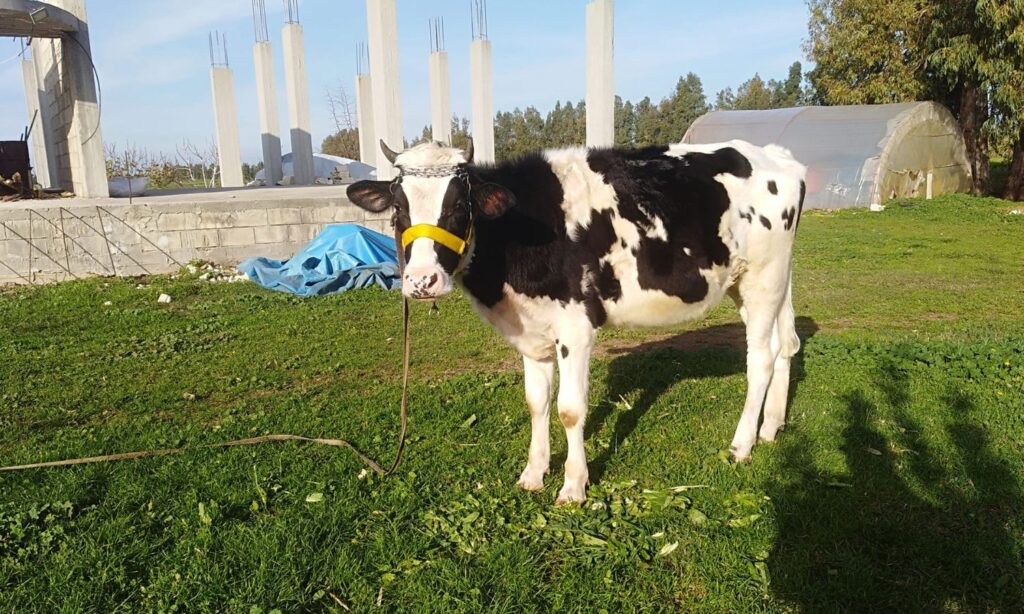Latakia – Linda Ali
“Abu Suleiman,” a sixty-something-year-old cattle breeder from the Latakia governorate, has sold most of his herd of cows, dwindling in number from seven in 2018 to just two today, due to the continuous rise in production costs and the decrease in purchasing power, which deprived him and other breeders of a profit margin from selling milk that would cover life necessities and be commensurate with their efforts.
Abu Suleiman, who lives in the village of al-Mkhtaraya in the Latakia countryside, said he is now considering keeping only one cow, after having paid about three million Syrian pounds in the summer of 2023 to treat one of his cows from hepatitis.
At the time of publishing this report, the exchange rate of one US dollar to the Syrian pound was recorded at 14,775 Syrian pounds, according to the S-P Today website, which specializes in currency exchange rates.
The breeder detailed the costs he incurs for raising cows, stating that each one requires feed worth 1.3 million pounds per month, in addition to another 75,000 pounds for straw, which is another type of feed made from dry wheat spikes.
Abu Suleiman buys the feed from the black market and prefers it over the feed he gets from official entities at a lower price, arguing that the feed provided by the Feed Corporation is “tampered, rotten, and worthless,” causing serious digestive diseases in cows.
Like many cattle breeders in Latakia, Abu Suleiman refuses to buy feed from the Feed Corporation for the same reason, and when they complain, they are told, “This is what’s available.”
In addition to the aforementioned costs, there are the expenses for veterinary care, where each visit costs no less than 100,000 pounds, including the check-up and transportation fees, as the veterinarian often comes on a motorcycle to reduce car (taxi) fares.
Also, a cow needs a vaccine every 20 days for an amount of 10,000 pounds, and vitamins costing 75,000 pounds every ten days.
Abu Suleiman added that his cow produces about 15 kilograms of milk daily on average, and he sells a kilo for 6,000 pounds, noting that he makes about 700,000 pounds per cow monthly, if he does not have to pay for the veterinarian’s services. He does not view this amount as equal to his significant effort in caring for the cows.
Bad drugs, Warnings of decreased amounts
Many cattle breeders affirm that the currently available veterinary medicines are of poor quality and do not meet required standards. In some cases, veterinarians advise giving cows human drugs, as they are more effective for animals.
This was the case for Jabir (58 years old), from the village of al-Hanadi south of Latakia, who bought more than 90 injections of human medicine for his young cow to treat hepatitis, noting that he paid more than 1.5 million pounds for them.
He said that throughout the treatment period, which lasted more than a month, he had to dispose of the milk because it was unfit for human consumption, which doubled his losses.
This was not the worst he recently faced, as his second cow suffered complications during pregnancy and childbirth, and natural birth was ineffective. He had to call a veterinarian who performed a cesarean section-like procedure, but the cow died, and he paid the vet 900,000 pounds.
The head of the Farmers’ Union branch in Latakia, Adib Mahfoud, warned of the extinction of livestock in the governorate due to the high production costs.
At the end of 2023, he stated that the number of cows in Latakia amounted to around 30,000 heads, noting that their breeding had decreased by 40%, which led to increased prices of their products.
He added that the rise in production costs imposes significant financial burdens on breeders, and what the Feed Corporation provides does not satisfy the needs of the cows.
On a national level in Syria, livestock and poultry breeders suffer various difficult circumstances, forcing many to consider leaving the profession, whether there are alternatives or not. Many are compelled to sell their livestock if buyers are available, or to slaughter them to rid themselves of the cost burden.
There are factors that affect the continuity of support for the livestock sector, including a significant decrease in grazing lands, and the death of a large number of livestock due to the spread of diseases among them, in addition to the high prices of veterinary drugs, as well as the high costs of feed. Moreover, the phenomenon of smuggling livestock to neighboring areas and countries to make a profit is also prevalent.

